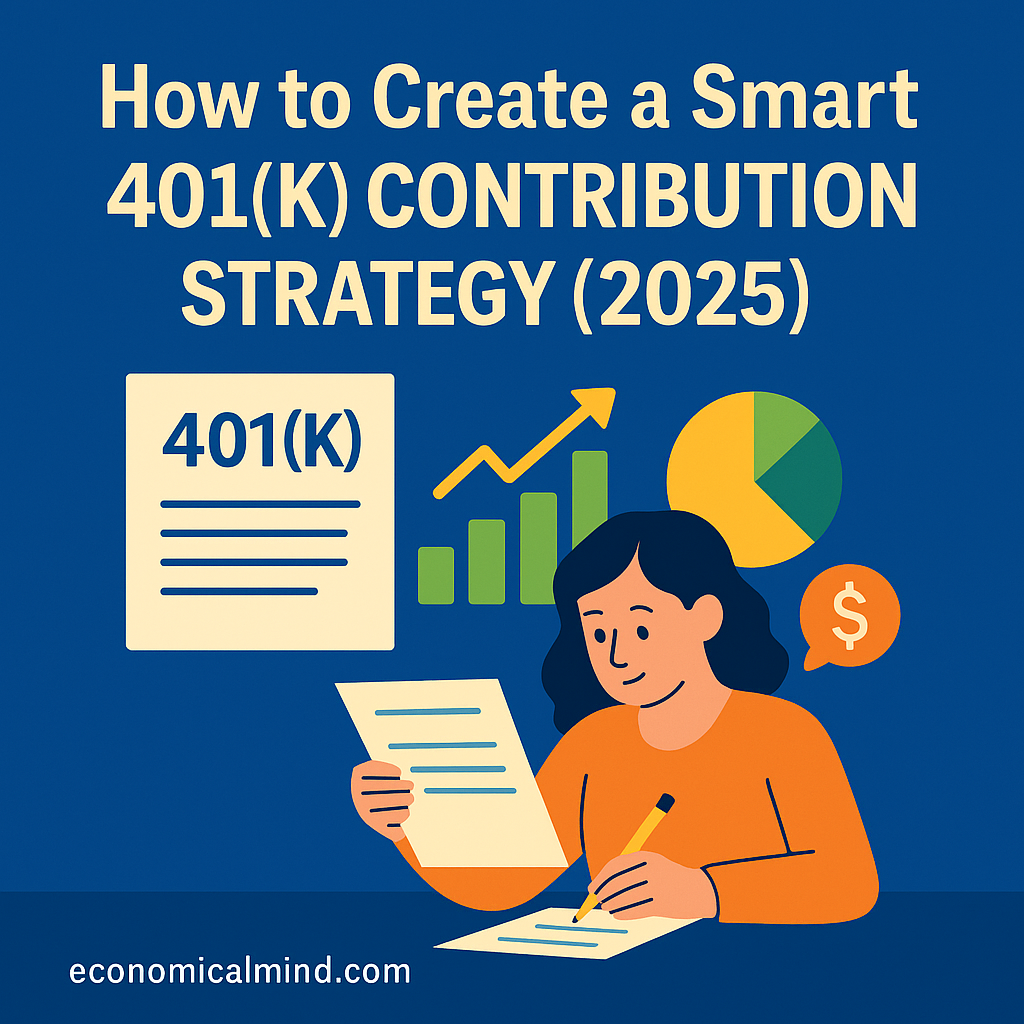
Why Your 401(k) Matters in 2025
Your 401(k) is one of the most powerful retirement tools available — especially in 2025, when tax advantages and employer matches can help you build wealth faster than ever.
But maximizing your 401(k) isn’t just about contributing — it’s about contributing strategically. How you allocate, match, and adjust your plan can make a six-figure difference by the time you retire.
Whether you’re just starting your first job or optimizing your mid-career portfolio, a smart contribution strategy will help you grow confidently toward financial freedom.
Step 1: Understand the Basics of a 401(k)
A 401(k) is an employer-sponsored retirement plan that lets you contribute a portion of your paycheck before taxes (traditional) or after taxes (Roth).
Your contributions are invested in funds — typically a mix of stocks, bonds, and index funds — which grow tax-advantaged until retirement.
For 2025, the IRS contribution limits are:
- $23,000 for individuals under 50
- $30,500 for those 50 or older (includes $7,500 catch-up contribution)
Step 2: Always Capture the Employer Match
If your employer offers a 401(k) match, never leave free money on the table.
For example, if your company matches 50% of the first 6% you contribute, and you earn $60,000, contributing 6% ($3,600) earns you an additional $1,800 — instantly increasing your total savings by 50%.
Even if you can’t max out your contributions yet, contribute at least enough to get the full employer match. It’s essentially a guaranteed 100% return.
Step 3: Choose Between Traditional and Roth 401(k)
In 2025, many employers offer both Traditional 401(k) and Roth 401(k) options:
| Type | When You Pay Taxes | Best For |
|---|---|---|
| Traditional 401(k) | Taxes deferred until retirement | Higher earners now, lower income later |
| Roth 401(k) | Taxes paid now, grows tax-free | Younger workers or those expecting higher income later |
If you’re unsure, consider splitting contributions between both types to balance your tax exposure in retirement.
Step 4: Determine Your Ideal Contribution Percentage
Financial experts recommend saving 15–20% of your income for retirement, including any employer match.
If that feels too high, start smaller:
- Year 1: Contribute 6%
- Year 2: Increase to 8%
- Year 3: Raise to 10% or higher
The key is consistency. Even small increases each year can significantly grow your retirement balance due to compounding interest.
Example:
Contributing $500 per month for 30 years at a 7% return grows to over $600,000.
Increase that to $700 per month, and you’ll reach nearly $850,000.
Step 5: Diversify Your Investment Mix
Your 401(k) typically offers mutual funds, index funds, and target-date funds.
A balanced portfolio might include:
- 60–80% stocks (growth)
- 10–30% bonds (stability)
- 5–10% cash equivalents (liquidity)
If you’re unsure, target-date funds are a simple, hands-off option — they automatically adjust your risk level as you approach retirement.
Example:
A “Target Retirement 2055” fund is designed for someone planning to retire around that year and will shift from growth-oriented to conservative investments over time.
Step 6: Take Advantage of Auto-Increase Features
Many employers allow you to automatically increase your contributions annually — often by 1% or 2%.
This feature makes it easy to save more without feeling the pinch.
For example, if you currently contribute 8% and add 1% each year, you’ll reach 15% in just seven years — a painless path to long-term wealth.
Step 7: Don’t Borrow From Your 401(k)
While some plans let you borrow against your 401(k), it’s almost always a bad idea.
When you withdraw funds early, you:
- Lose compounding growth
- Pay taxes and potential penalties
- Risk derailing your retirement goals
Treat your 401(k) as untouchable money for future you — not an emergency fund.
Step 8: Rebalance Your Portfolio Annually
Market fluctuations can throw off your original asset mix. For instance, if stocks outperform, your portfolio may become riskier than intended.
Rebalancing once a year realigns your investments to your target allocation (e.g., 70% stocks, 30% bonds), keeping your risk and reward balanced.
Many 401(k) platforms let you set automatic rebalancing — an easy way to maintain your strategy without extra effort.
Step 9: Consider Catch-Up Contributions (50+)
If you’re 50 or older in 2025, you can contribute an additional $7,500 in catch-up contributions — raising your total annual limit to $30,500.
This is especially valuable if you started saving later in life and need to accelerate your retirement growth.
Step 10: Review Your Strategy Yearly
Life changes — your 401(k) should too. Review your contribution rate, tax status, and investment mix every year or after major life events (job change, marriage, income shift).
Use this time to:
- Increase your contribution percentage
- Adjust risk levels based on your age
- Revisit whether Roth or Traditional makes more sense
A quick annual check-up can keep your plan optimized for your evolving goals.
Quick Tips for a Smarter 401(k)
- Contribute at least enough to get the full employer match.
- Reinvest dividends for compound growth.
- Avoid early withdrawals or loans.
- Review fees — lower expense ratios mean higher long-term returns.
- Stay invested during market dips; time in the market beats timing the market.
Final Thoughts
A 401(k) isn’t just a retirement account — it’s your ticket to long-term financial independence.
In 2025, the best 401(k) contribution strategy balances consistency, growth, and tax efficiency. Start where you are, automate your savings, and let time and compounding do the heavy lifting.
Small, steady contributions today can build the future you’ve always imagined — one paycheck at a time.
